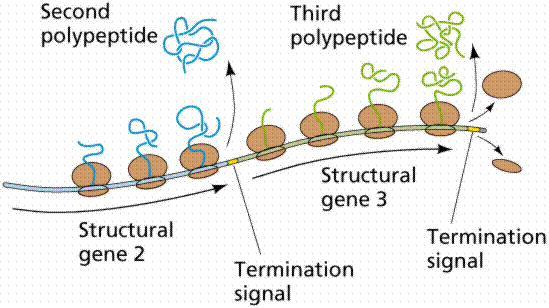 Therapy for cancers is currently based
on understanding genes.
Therapy for cancers is currently based
on understanding genes. Therapy for cancers is currently based
on understanding genes.
Therapy for cancers is currently based
on understanding genes.
“Where once we viewed cancer as a bewildering variety of diseases with causes too numerous to count,” Bishop writes, “now we are on the track of a single unifying explanation for how most or all cancers might arise. The track is paved with cells.”
But genes are not what you or your Grandfather thought they were.
One gene = one trait, not quite
One gene mutation = one disease, not entirely
An oncogene is a tumor inducing strand of DNA that may or is capable of making a defective protein.
These persisting oncogenes are manifest as post reproductive problems that evolution would not have weeded out by means of natural selection. That is because natural selection works to allay or push forward reproduction. Those traits that are debilitating are not always screened out.
![]()
Defining character | Examples | Human chromosomes | paths | therapy | sources | terms
Proto-Oncogenes
such as the
RAS gene
HK&N or KRAS, or NRAS, or
HRAS is bladder cancer, for example
A damaged proto-oncogene, damaged genetically (a mutant) for example is often a code problem where:
GGC ---> glycine is changed to valine ----> GTC
Genes

Repressing an expression of genes in replication:
![]()
Defining character | Examples | Human chromosomes | paths | therapy | sources | terms
![]()
Inherited tumors
RetinoBlastoma
translated from one generation to the next
on Chromosome
# 13
has a deletion or loss of genetic information to cause the tumor.
By 1986 they found the retinoblastoma gene
it is a genetic lesion that is formed.
There is a mutation in the inheritance of the tumor suppresser genes keep such tumors under control
Genetic lesions in cancer cells.
Colon cancer increases with age and the result of multiple events, or several steps from two to a dozen steps. There are 30 steps to production of prostate cancer.
Peter Noll, 1976
Every tumor represents a biological experiment that is ruthlessly selected for by evolution and demonstrates the relentless selection pressures on vital genes.
![]()
Genetic damage is the current path to cancer:
in either proto-oncogenes (GO switch or jammed accelerator)
or
tumor suppresser genes (STOP switch or defective brake)
Characteristics of cancer
- excessive proliferation
- impeded maturation
- Unstable genetics
- defective cellular suicide (cells do not die, when they should).
- angiogenesis
- hyperkinetic
- abnormal invasiveness
- metastasizes
Sun exposure to radiation
skin cancer
GCCA mutates to GTTA when irradiated by UV frequencies
p53 gene is damaged
DNA exposed to ultraviolet radiation
Bladder Cancercan be affected by early detection
by genetic cytology
PSA testcan detect two kinds of tumors (both bad --prone to metastasize-- and benign
Defining character | Examples | Human chromosomes | paths | therapy | sources | termsTherapy
Therapeutic regimes.
Protein handmaidens of genes can be targeted: (exquisite selectivity)
a malfunctioning switch
- retinoic acid (APL) binds to mutant protein – 1987 – Leukemia (vitamin A therapy) chromosomal abnormality
- Breast Cancer – Herceptin is not curative – but does help in some breast cancers
- Gleevec – effective in the early phase of some types of Leukemia (resistance in tumor occurs)
- Iressa can arrest the broken switch in certain cancer maladies. (Lung Cancer effective in 10%)
Defining character | Examples | Human chromosomes | paths | therapy | sources | terms
"Playing on a genetic keyboard."
He was awarded the Nobel Prize for "discovering within normal cells certain growth-controlling genes which, when mutated, play a role in initiating growth of cancerous tissues."
Dr. J. Michael Bishop, lecture, 2005, UCSB
How to Win the Nobel Prize: An Unexpected Life in Science, was published in May 2003, by Harvard University Press.
"Bishop’s story proceeds through five levels of scientific insight. First came the understanding that cancer is a cellular inheritance: it begins in a single cell and passes its malignant potential to subsequent generations of cells. Second, scientists learned that a carcinogenic event is usually set off by some external factor: cancer begins with disruptive exposure to sunlight, x-rays, smoking, a dangerous chemical. Third, that event is mutagenic: the DNA is somehow deranged, because genes are mislocated among different chromosomes (as in the "Philadelphia chromosome" associated with chronic myelogenous leukemia), or changed at a precise point, or overgrown (a hyperprevalence called "amplification"). Fourth, as they use cells to effect their own replication, certain viruses can convert benign proto-oncogenes into cancer agents—a vital finding, because the simple genetic structure of viruses is much more readily susceptible to study than is that of cellular species. Finally, the rare, truly inherited cancers reveal the repair genes and "suppressor genes" whose loss or malfunction permits other mutations to proceed to the point of tumorigenesis."
proto-oncogene
A proto-oncogene is a normal gene that can become an oncogene due to mutations or increased expression.
- Proto-oncogenes code for proteins that help to regulate cell growth and differentiation. [More]
- Proto-oncogenes are often involved in signal transduction and execution of mitogenic signals, usually through their protein products.
- Upon ''activation'', a proto-oncogene (or its product) becomes a tumor-inducing agent, an oncogene.
Medical News, (2014).
The Century of the Gene, published in 2000.
![]()
Diversity of Life | Triple Helix | Darwin | Dawkins | Margulis | Mayr |DNA | Double Helix | Ehrlich | Dubos | Tattersall | Wilson